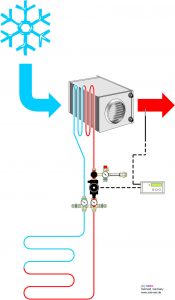In winter, ventilation systems can be highly efficient heat recovery (HR) in very cold outdoor air (eg -12 ° C) to cool the hot exhaust air of the house theoretically well below freezing. Here, however, the water vapor in the exhaust heat exchanger in the heat recovery system would not only condense into water, but frozen to ice. The ice would clog the heat exchanger and could break. To avoid this it must be ensured that the incoming fresh air is preheated so far that it no longer cools the air below the freezing point for highly efficient heat recovery systems.The necessary preheating temperature depends on the efficiency of the heat recovery exchanger. At 80% heat recovery, preheating is sufficient to approximately -4 ° C, with 98% heat recovery ranges from preheating to about -1 ° C to make sure the antifreeze.
The earth is warm in 1.5 to 3 m deep in the cold winter between +5 and +8 ° C. With a ne tec brine-air heat exchanger can remove it with enough heat to preheat outside air minusgrädige sufficient. This one moved a brine line into the earth and builds a special brine-air heat exchanger in the outdoor air intake in the heat of the brine to the passing air is transferred. In the brine line is a pump assembly installed. To control the whole there is a temperature-controlled variable brine pump regulator .
Preheating the outside air with a ne tec brine-air heat recovery EWT is also in systems with so-called "integrated frost protection" makes sense.Indeed, this is usually only a forced shutdown or reduction of the supply fan in acute danger of icing of the WRG. In this mode of operation of the ventilation system is indeed blown a lot of hot air, but only little or no cold outside air sucked more. Thus, the heat exchanger is warm again ("antifreeze"), but the fresh air and the recovery of total or partial. The house creates a vacuum and the lack of supply air is sucked in through cracks and joints in the building envelope. This is not advantageous in the cold winter.
ne tec saltwater EWT warm in winter, the fresh air with geothermal energy and also allow for very cold outdoor temperatures, a balanced ventilation system with full utilization of the WRG.
In the hot summer you want to keep a cool house. But how can we avoid unwanted overheating? Of course, first by being denied access to the outside heat into the house. Well insulates heat, keep the windows closed and shaded windows and doors on the ground floor and floor to ceiling windows in the Oberg bolting on a hot day, so that the "cold-air bath" in the house does not drain to the outside. High window or skylights can open it.
Furthermore, you can perform with the cool fresh air ventilation system and dissipate hot air inside. Since the Earth is much cooler in the hot summer of 1-3 m in depth than the outside air, they can be using a ne tec use brine-air heat exchanger as a free cooling source to pre-cool the hot outside air. The brine is then cooled in erdkühle brine-air heat exchanger, the hot air intake eg +36 ° C to +24 ° C without air conditioning. The house can be reached thanks to free Erdkühle with 40 watts power circulators up to 2 kilowatts cooling effect.
Conclusion: in winter and summer help
ne tec brine-air heat exchanger to preheat fresh air in winter and summer minusgrädige hot pre-cool fresh air.They increase the efficiency of the ventilation system and the comfort. Therefore they are often installed in passive houses or other buildings with efficient ventilation system.


No comments:
Post a Comment